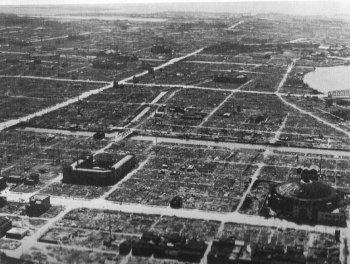![]() The Pacific War Online Encyclopedia
The Pacific War Online Encyclopedia
|
| Previous: Tokuyama | Table of Contents | Next: Tolland Class, U.S. Attack Cargo Ships |

Smithsonian Institution. Via ibiblio.org. Fair use may apply.
(139.778E 35.704N) In 1941, the greater Tokyo area had a population of 10 million persons, concentrated along the western shore of Tokyo Bay. Tokyo itself had a population of 6,778,804 persons in October 1940. This was Japan’s most important governmental, industrial, and commercial center. There were major shipbuilding facilities at Kawasaki and Yokosuka and numerous airfields in the area, including an Army airfield at Haneda. Tokyo itself hosted a shipyard owned by Ishikawajima Heavy Industries.

National Archives. Via Frank (1999)
On 9-10 March 1945, Tokyo was attacked by 279 B-29 Superfortresses
loaded with 1650 tons of
incendiary bombs. The city was
experiencing a windstorm at the time, with gusts of up to 70 miles per
hour (110 km/h), which fanned the fires into a firestorm. The attack
burned out over 10,000
acres (4000 hectares) of the city, killing
between 80,000 and 120,000 persons and leaving a million more homeless.
Some 1.7
million residents had already left the city, and many more fled after
the attack. Tokyo was firebombed two more times before the surrender, but casualties in these
attacks were much lighter, due to the weather
being less favorable for the attackers and to the unwillingness of
civilians to pay any further heed to government exhortations to fight
the fires rather than flee for their lives.
Antiaircraft defenses at the time of the attack amounted to 3067 automatic weapons and 331 heavy antiaircraft guns. Lemay ordered his aircraft to fly at an altitude between 5000 and 7800 feet (1500m to 2400m) which was above the range of the automatic weapons but low enough to evade the heavier guns. Only 74 Japanese fighters were encountered, and these managed only 40 attacks. Twelve B-29s were lost in the raid.
Wolk (2010) has aptly described the raid as "... the single greatest disaster suffered by any nation in the history of war."
On 25-26 May 1945, another raid by 498 B-29s met much
increased fighter and antiaircraft opposition, losing 26 aircraft, the
most on any single mission of the war. Some 3262 tons of incendiaries
were dropped on the city, destroying twenty square miles of the city
(5200 hectares). The destruction included 27 buildings of the Imperial
Palace complex, which came as a profound shock to the Japanese, who
seemed to believe that the survival of the Palace to that point was
proof of divine protection. It was the last firebombing raid on Tokyo during the war; there was nothing left worth burning.
Showa Hikoki K.K. The production schedule of this small aircraft factory was approximately as follows:
| Aircraft Type | Average Airframes Per Month | Starting Month | Ending Month |
|---|---|---|---|
| D3A Val |
6 | 1942-12 |
1945-8 |
| Yard |
Floor Space |
Building Way Length |
Merchant Tonnage |
Naval Tonnage |
|---|---|---|---|---|
| Ishikawajima |
1340 |
2441 |
2993 |
173 |
| Uraga |
814 |
2685 |
2243 |
532 |
| Konan-Mitsubishi |
384 |
1200 |
1112 |
0 |
| Tokyo |
895 |
2362 |
1352 |
2120 |
| Senshu-Kawasaki |
435 |
2271 |
0 |
173 |
| Shimizu |
183 |
469 |
52 |
0 |
Climate Information:
Elevation 19'
Temperatures: Jan 47/29, Apr 63/46, Jul 83/70, Oct 69/55, record 101/17
Rainfall: Jan 5/1.9, Apr 10/5.3, Jul 10/5.6, Oct 11/8.2 == 61.6" per annum
References
The Pacific War Online Encyclopedia © 2007-2009, 2011 by Kent G. Budge. Index